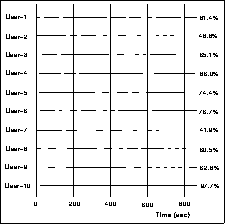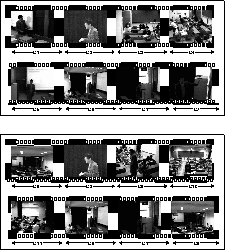
Figure 4: Detected A-components
Publication,
Research,
Docs and Info,
KAMEDA
We conducted a experiment on a lecture. The imaging agents used four active cameras (e) - (h) in Figure3. We prepared 10 users and they proclaimed 141 camera-works in their imaging rules in the experiment, and 43 out of them are different camera-works.
Figure4 shows the detected dynamic situations in the example lecture. The line indicates the periods that the dynamic situation labeled at the left is detected (see also Table1). Multiple dynamic situations are detected from time to time simultaneously.

Figure 4: Detected A-components
Figure5 shows the lasting
period of the requested video image by each user. The line along the
time axis represents the duration when the user watched the video image
taken by his/her own imaging rule.
As the duration is longer, the user's imaging rule is realized for longer
time.
The right figures show the percentage of the realized period against
the whole period. Although there are only four cameras for the
imaging agents,
10 users could watch their favorite video images in  period.
period.

Figure 5: Duration of realized imaging rules
An example snapshot of the camera-works is shown in Figure6. It corresponds to the camera-work of w(lecturer, right front, medium shot).

Figure 6: w(lecturer, right front, medium shot)
We show the two snapshot sequences of the video images taken from the lecture. The video images in Figure7 and Figure8 are generated for the different users for about five minutes. User (A) proclaimed seven camera-works whereas user (B) proclaimed seven different camera-works . The horizontal axis indicates the time flow and C1 to C11 are labels of the selected camera-works.
Note that both users sometimes watch the same video image because their desired camera-works are overlapped at that time.

Figure 8: Video images for user (B)
Figure 7: Video images for user (A)